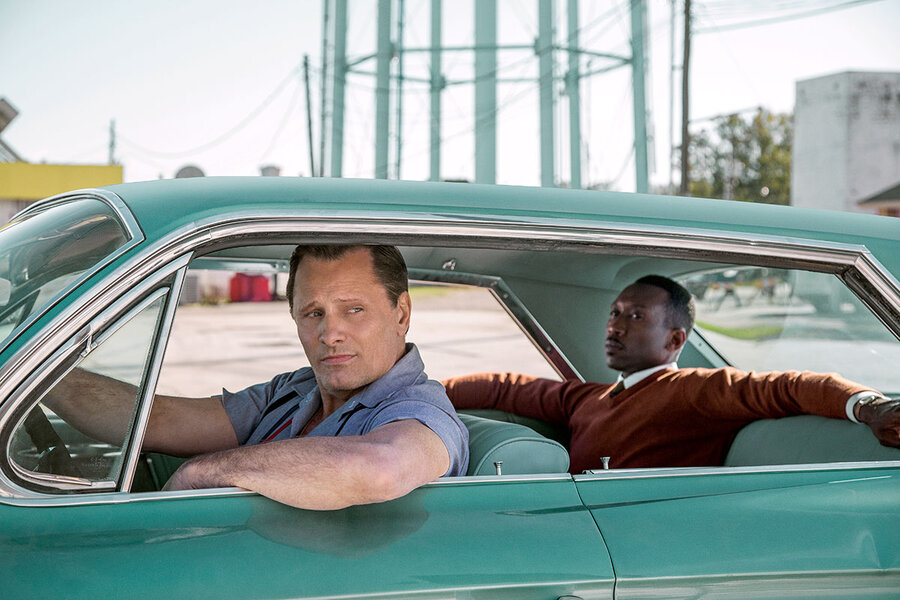In 'Green Book,' lessons are learned in Jim Crow South
Loading...
There are certain movies that shamelessly manipulate you and yet, even while knowing this, you fall for them anyway. Such a movie is “Green Book,” an audience pleaser of the first magnitude that floated merrily above my many objections.
Based on true events, the film is set in 1962, when we are first introduced to Frank Anthony Vallelonga, aka “Tony Lip” (Viggo Mortensen), a cocky Italian-American bouncer at the Copacabana nightclub in New York City whose nickname comes from his genius for talking his way out of anything. He’s also good with his fists, which is why Dr. Don Shirley (Mahershala Ali), a classically trained African-American jazz pianist, hires him to be his driver and bodyguard on an extended winter music tour with his trio through the Deep South.
It’s already been established that Tony, who has a doting wife, Dolores (Linda Cardellini), and kids, and an extended family of generic Italian-American yammerers, is rather racist, but he takes the job because he needs the money. Doc isn’t crazy about the arrangement, either – temperamentally, he’s practically a mute compared to the gabby Tony. But of course, as they journey into the Jim Crow South, these polar opposites discover their common humanity and life lessons sprout right on schedule.
We’re supposed to find it funny that Doc, who lives in a spacious apartment above Carnegie Hall and carries himself with an effete imperiousness, has never heard the music of Little Richard or Chubby Checker. “These are your people!” a flabbergasted Tony tells him. Tony also introduces him to the joys of eating fried chicken and tossing the bones out the window of their Coupe de Ville. Doc, for his part, helps Tony write tender love letters to Dolores. Presumably Cyrano de Bergerac was unavailable.
As they venture deeper into the South, guided by the Negro Motorist Green Book that was published in that era as a travel guide to black-friendly restaurants and hotels, the levity remains but the mood darkens somewhat, although the movie is never in the slightest danger of turning into something James Baldwin or Spike Lee might endorse. It’s closer to a racially reversed “Driving Miss Daisy,” with a bit of “A Christmas Carol” thrown in as garnish.
We are told that Doc, who doesn’t need the money, not to mention the grief, is undertaking this tour because he wants to make a political point. This social-activist motivation doesn’t really come through in Ali’s performance, though. Doc is a sullen, private man, a heavy drinker who feels debased by having to play light jazz when he should be playing Chopin for the moneyed, mostly white high-society folk who pay to hear him. And Tony, who is shown in the beginning trashing two drinking glasses in his kitchen because some black workers drank from them, too quickly shucks his prejudices.
All these objections, and more, are valid, but as I warned at the outset, they don’t really matter. This film cuts right through your defenses. That’s because the performances by the two actors, especially Mortensen, are so hugely entertaining. Peter Farrelly, who directed and co-wrote the script with Brian Hayes Currie and Tony Lip’s son Nick Vallelonga, also co-directed “Dumb & Dumber” and “There’s Something About Mary.” He knows how to work a comedy sketch (if not moments of high drama, like the one in which Tony rescues Doc from belligerent white patrons in a bar fight).
Ali gives a fine-tuned portrait of a proud man who feels lost in the worlds of both white and black. He has a powerfully plaintive moment when he cries out, “What am I?” Mortensen, who reportedly put on thirty pounds for the role, starts out playing Tony like a big lug but as the road trip ensues he brings all sorts of subtle shadings to the role. He even comes to appreciate Doc’s artistry. In Tony’s eyes, he’s right up there with Liberace. Grade: B+ (Rated PG-13 for thematic content, language including racial epithets, smoking, some violence and suggestive material.)







